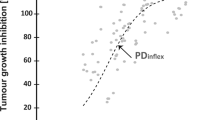Abstract
Y15 or inhibitor 14 (1,2,4,5-benzenetetramine tetrahydrochloride) is a potent and specific inhibitor of focal adhesion kinase that inhibits its autophosphorylation activity, decreases the viability of cancer cells, and blocks tumor growth. In this preclinical study, we analyzed the pharmacokinetics of Y15 in mice plasma, its metabolic stability in mouse and human liver microsomes and toxicity in mice. The pharmacokinetics study in mice demonstrated that, following intraperitoneal administration at 30 mg/kg dose, Y15 was very rapidly absorbed in mice, reaching maximum plasma concentration in 4.8 min. Y15 rapidly metabolized in mouse and human liver microsomes with half-life t1/2 of 6.9 and 11.6 min, respectively. The maximal tolerated dose of single-dose administration of Y15 by oral administration was 200 mg/kg, and the multiple maximum tolerated dose of Y15 was 100 mg/kg by PO during 7 day study. Y15 did not cause any mortality or statistically significant differences in the body weight at 30 mg/kg by IP during 28-day study, and at 100 mg/kg by PO during the 7-day study. There were no clinical chemical, hematological, or histopathological changes in different mice organs at 30 mg/kg by IP during 28 days and at 100 mg/kg dose by PO during 7 days. Thus, this is the first preclinical toxicity, pharmacokinetics, and metabolic stability study of Y15 inhibitor. Further development of Y15 will provide a basis for new therapeutic and future clinical studies.


Similar content being viewed by others
References
Beierle EA, Massoll NA, Hartwich J et al (2008) Focal adhesion kinase expression in human neuroblastoma: immunohistochemical and real-time PCR analyses. Clin Cancer Res 14(11):3299–3305
Beierle EA, Ma X, Stewart J et al (2010) Inhibition of focal adhesion kinase decreases tumor growth in human neuroblastoma. Cell Cycle 9(5):1005–1015
Cance WG, Golubovskaya VM (2008) Focal adhesion kinase versus p53: apoptosis or survival? Sci Signal 1(20):pe22
Cance WG, Harris JE, Iacocca MV et al (2000) Immunohistochemical analyses of focal adhesion kinase expression in benign and malignant human breast and colon tissues: correlation with preinvasive and invasive phenotypes. Clin Cancer Res 6(6):2417–2423
Cance WG, Kurenova E, Marlowe T, Golubovskaya V (2013) Disrupting the scaffold to improve focal adhesion kinase-targeted cancer therapeutics. Sci Signal 6(268):pe10. doi:10.1126/scisignal.2004021
Golubovskaya VM, Cance WG (2007) Focal adhesion kinase and p53 signaling in cancer cells. Int Rev Cytol 263:103–153
Golubovskaya VM, Nyberg C, Zheng M et al (2008) A small molecule inhibitor, 1,2,4,5-benzenetetramine tetrahydrochloride, targeting the Y397 site of focal adhesion kinase decreases tumor growth. J Med Chem 51:7405–7416
Golubovskaya VM, Huang G, Ho B et al (2013) Pharmacologic blockade of FAK autophosphorylation decreases human glioblastoma tumor growth and synergizes with temozolomide. Mol Cancer Ther 12(2):162–172. doi:10.1158/1535-7163.MCT-12-0701
Heffler M, Golubovskaya VM, Dunn KM, Cance W (2013) Focal adhesion kinase autophosphorylation inhibition decreases colon cancer cell growth and enhances the efficacy of chemotherapy. Cancer Biol Ther 14(8):761–772
Hochwald SN, Nyberg C, Zheng M et al (2009) A novel small molecule inhibitor of FAK decreases growth of human pancreatic cancer. Cell Cycle 8(15):2435–2443
Lark AL, Livasy CA, Calvo B et al (2003) Overexpression of focal adhesion kinase in primary colorectal carcinomas and colorectal liver metastases: immunohistochemistry and real-time PCR analyses. Clin Cancer Res 9(1):215–222
Lark AL, Livasy CA, Dressler L et al (2005) High focal adhesion kinase expression in invasive breast carcinomas is associated with an aggressive phenotype. Modern Pathol 18(10):1289–1294
Owens LV, Xu L, Craven RJ et al (1995) Overexpression of the focal adhesion kinase (p125FAK) in invasive human tumors. Cancer Res 55(13):2752–2755
Owens LV, Xu L, Dent GA et al (1996) Focal adhesion kinase as a marker of invasive potential in differentiated human thyroid cancer. Ann Surg Oncol 3(1):100–105
Schaller MD (2010) Cellular functions of FAK kinases: insight into molecular mechanisms and novel functions. J Cell Sci 123(Pt 7):1007–1013. doi:10.1242/jcs.045112
Acknowledgments
The work was supported by NIH Grant CA65910 (WGC) and Susan G. Komen for the Cure BCTR0707148 (VMG) and partly by the NCI Cancer Center Support grant to the Roswell Park Cancer Institute (CA 16056).
Conflict of interest
Dr. Vita Golubovskaya and Dr. William Cance are co-founders and stockholders of CureFAKtor Pharmaceuticals.
Author information
Authors and Affiliations
Corresponding authors
Rights and permissions
About this article
Cite this article
Golubovskaya, V., Curtin, L., Groman, A. et al. In vivo toxicity, metabolism and pharmacokinetic properties of FAK inhibitor 14 or Y15 (1, 2, 4, 5-benzenetetramine tetrahydrochloride). Arch Toxicol 89, 1095–1101 (2015). https://doi.org/10.1007/s00204-014-1290-y
Received:
Accepted:
Published:
Issue Date:
DOI: https://doi.org/10.1007/s00204-014-1290-y




